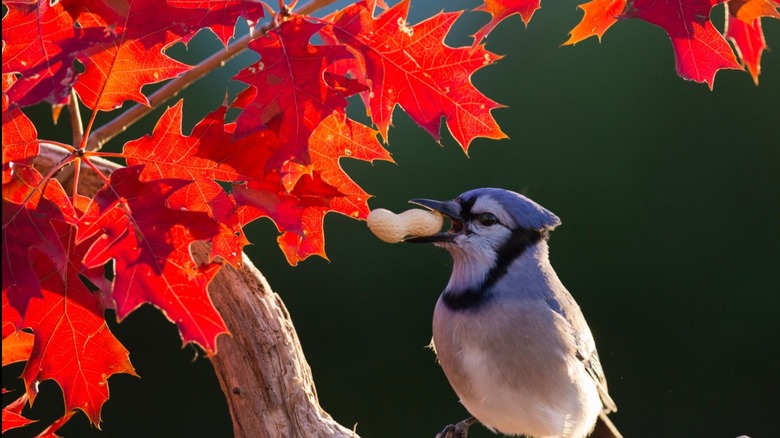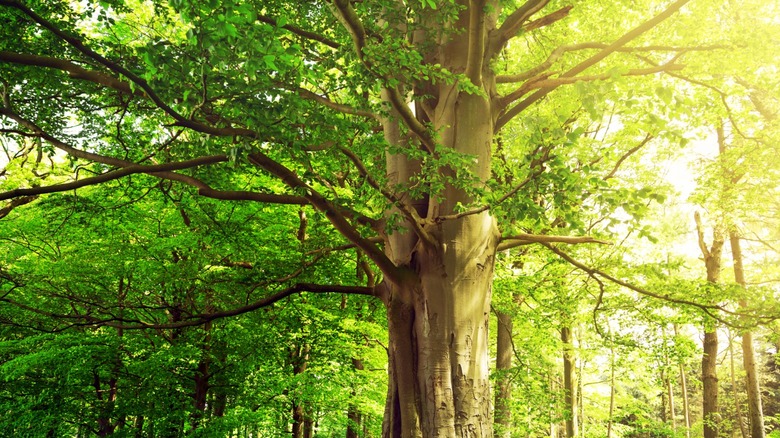Garden Trees, Shrubs & Vines
Rochelle Heath-Harris
If you’re a fan of birdwatching, blue jays can be one of the most interesting birds to attract to your yard. Yes, they can be bullies at the bird feeder, but they make up for it by sounding the warning cry when predators are nearby. They have a myriad of vocalizations and are highly intelligent. Plus, their beautiful blue feathers brighten up any landscape. And, in case you didn’t know, two of its favorite foods are acorns and beechnuts. That equals two trees you can plant that are guaranteed to attract blue jays to your property — oak and beech.
Speaking of blue jays and oak trees, it’s believed that blue jays were a huge propagator of oak trees after the last ice age, mainly because of the way they store and eat them. A single blue jay hides an average of 3,000 to 5,000 acorns over its lifetime, burying them individually and over a large area at a time. Amazingly, most of the acorns are accounted for, but of course, there’s always going to be a percentage that gets left behind. Because of those, more oak trees are sprouting every year, and hopefully always will be. This is just one of the miracles of Mother Nature. This is natural sustainability in action.
Plant an oak tree

Mircea Costina/Shutterstock
Interestingly enough, it’s possible to take a few acorns you might be able to collect, and with a little preparation, plant them and grow an oak tree. While it’s true they’re slow growers, when they mature they’re splendid giants. Moreover, they’re great for the environment in a multitude of ways. Oak trees are wonderful for native wildlife in general, and blue jays will definitely be around. It’s best to plant them outside, within a few days of collecting them, but be prepared to provide protection for the sapling from animals for the first few years of its life.
Wait until the trees dropping acorns have dropped the majority of their burden to the ground, but before they all get plundered by birds and other animals. Plant within a few days with potting mix for the best start. You can start them in pots for easier protection until they go in the ground, or straight into the ground if you prefer. Plant them sideways or horizontally, and put two acorns in one pot. When the seedlings are about one to two weeks old, cut off the weaker one at soil level. The roots are already entangled, so don’t try to pull it out by hand. You will need a mesh tree guard for at least the first three years.
Plant a beech tree

Gabriele Rohde/Shutterstock
An adult beech tree ranges from 50 to 80 feet tall and can spread from between 40 and 80 feet wide. It produces beechnuts, which are nutrition for a variety of wildlife, including blue jays and other birds. Some birds also eat the buds from these trees, and the trees can live more than 150 years. Planting a beech tree from seed can take 40 years or more before it’s mature enough to begin flowering and producing beechnuts. You’ll want to be vigilant about cutting suckers off, as they will be persistent.
One good thing is that the tree produces both male and female flowers, so keeping it healthy and well-watered is believed to encourage more beechnuts. You can plant a beech tree in much the same way as an oak — gather dry, ripe beechnuts in the fall from the tree. Plant just one in each container filled with potting mix. Cover the beechnut with about half an inch more potting mix and set in a window or bright spot for the first year. Transplant into a large container and wait for it to grow one to three feet tall, at which time it can be planted outdoors in a permanent location. Just understand that it might be several years before it gets to this height. Until your trees get bigger, you can attract blue jays with the foods they love and the feeders they prefer.



